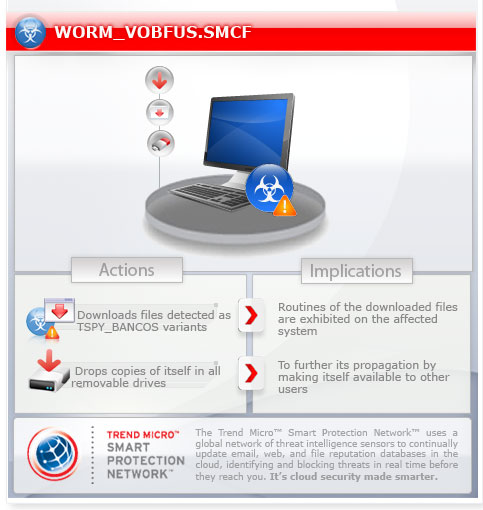WORM_VOBFUS.SMCF
Worm:Win32/Vobfus.MB (Microsoft), W32.Changeup (Symantec), W32/Autorun.worm.aaeb (McAfee)
Windows 2000, Windows XP, Windows Server 2003


Threat Type: Worm
Destructiveness: No
Encrypted: Yes
In the wild: Yes
OVERVIEW
Trend Micro has received multiple samples of this malware from multiple sources, including customer reports and internal sources. This malware has been noted to employ polymorphism in order to prevent early detection. It uses Facebook as a means to propagate. It also downloads information-stealing malware onto the affected system.
To get a one-glance comprehensive view of the behavior of this Worm, refer to the Threat Diagram shown below.

For the related story, you may read the following blog posts:
This worm has been seen to spread on Facebook.
Whenever it drops a folder, it hides the legitimate folder with the same name in order to escape detection.
It downloads a variant of TSPY_BANCOS onto the affected system, which can steal important personal information such as online banking login details.
This worm arrives by connecting affected removable drives to a system. It arrives on a system as a file dropped by other malware or as a file downloaded unknowingly by users when visiting malicious sites.
It drops an AUTORUN.INF file to automatically execute the copies it drops when a user accesses the drives of an affected system.
It executes the downloaded files. As a result, malicious routines of the downloaded files are exhibited on the affected system.
TECHNICAL DETAILS
Arrival Details
This worm arrives by connecting affected removable drives to a system.
It arrives on a system as a file dropped by other malware or as a file downloaded unknowingly by users when visiting malicious sites.
Installation
This worm drops the following copies of itself into the affected system:
- %User Profile%\{random file name}.exe
- %User Profile%\Passwords.exe
- %User Profile%\Porn.exe
- %User Profile%\Secret.exe
- %User Profile%\Sexy.exe
(Note: %User Profile% is the current user's profile folder, which is usually C:\Documents and Settings\{user name} on Windows 2000, XP, and Server 2003, or C:\Users\{user name} on Windows Vista and 7.)
It drops the following files:
- {drive letter}:\x.mpeg
Autostart Technique
This worm adds the following registry entries to enable its automatic execution at every system startup:
HKEY_CURRENT_USER\Software\Microsoft\
Windows\CurrentVersion\Run
{random file name}.exe = "%User Profile%\{random file name}.exe /{random character}"
Other System Modifications
This worm adds the following registry entries:
HKEY_LOCAL_MACHINE\SOFTWARE\Policies\
Microsoft\Windows\WindowsUpdate\
AU
NoAutoUpdate = "1"
It modifies the following registry entries:
HKEY_CURRENT_USER\Software\Microsoft\
Windows\CurrentVersion\Explorer\
Advanced
ShowSuperHidden = "0"
(Note: The default value data of the said registry entry is 1.)
Propagation
This worm drops the following copy(ies) of itself in all removable drives:
- {drive letter}:\{random file name}.exe
- {drive letter}:\Passwords.exe
- {drive letter}:\Porn.exe
- {drive letter}:\Secret.exe
- {drive letter}:\Sexy.exe
- {drive letter}:\{folder name}.exe
It drops an AUTORUN.INF file to automatically execute the copies it drops when a user accesses the drives of an affected system.
The said .INF file contains the following strings:
{garbage characters}
[autorun]
{garbage characters}
open={random}.eXE
{garbage characters}
ACTION={random number}
UseautopLAY=1
{garbage characters}
Download Routine
This worm accesses the following websites to download files:
- http://{random number}.{BLOCKED}.eu:443/cWWFwy?d
- http://{random number}.{BLOCKED}1.eu:443/cWWFwy/?d
- http://{BLOCKE}D1.{BLOCKED}ecks.net
It saves the files it downloads using the following names:
- %User Profile%\google.com
It then executes the downloaded files. As a result, malicious routines of the downloaded files are exhibited on the affected system.
NOTES:
It uses the filenames of files with the following extensions:
- .avi
- .bmp
- .doc
- .gif
- .jpe
- .jpg
- .mp3
- .mp4
- .mpg
- .png
- .tif
- .txt
- .wav
- .wma
- .wmv
- .xls
It then sets the attribute of the original folder to Hidden and System to trick users into thinking that the dropped copy is the legitimate folder.
It also drops to mapped network drives the same copies of itself as dropped in removable drives.
Trend Micro detects the downloaded file %User Profile%\google.com as variants of TSPY_BANCOS. The contents of the downloaded file can be changed at any time by the malware writer.
SOLUTION
Step 1
For Windows XP and Windows Server 2003 users, before doing any scans, please make sure you disable System Restore to allow full scanning of your computer.
Step 2
Remove malware files dropped/downloaded by WORM_VOBFUS.SMCF
- TSPY_BANCOS
Step 3
Scan your computer with your Trend Micro product and note files detected as WORM_VOBFUS.SMCF
Step 4
Restart in Safe Mode
Step 5
Delete this registry value
Important: Editing the Windows Registry incorrectly can lead to irreversible system malfunction. Please do this step only if you know how or you can ask assistance from your system administrator. Else, check this Microsoft article first before modifying your computer's registry.
- In HKEY_CURRENT_USER\Software\Microsoft\Windows\CurrentVersion\Run
- {random file name} = "%User Profile%\{random file name}.exe /{random character}"
- {random file name} = "%User Profile%\{random file name}.exe /{random character}"
- In HKEY_LOCAL_MACHINE\SOFTWARE\Policies\Microsoft\Windows\WindowsUpdate\AU
- NoAutoUpdate = "1"
- NoAutoUpdate = "1"
Step 6
Restore these modified registry values
Important:Editing the Windows Registry incorrectly can lead to irreversible system malfunction. Please do this only if you know how to or you can seek your system administrator's help. You may also check out this Microsoft article first before modifying your computer's registry.
- In HKEY_CURRENT_USER\Software\Microsoft\Windows\CurrentVersion\Explorer\Advanced
- From: ShowSuperHidden = "0"
To: ShowSuperHidden = "1"
- From: ShowSuperHidden = "0"
Step 7
Search and delete AUTORUN.INF files created by WORM_VOBFUS.SMCF that contain these strings
[autorun]
{garbage characters}
open={random}.eXE
{garbage characters}
ACTION={random number}
UseautopLAY=1
{garbage characters}
Step 8
Search and delete this file
- {drive letter}:\x.mpeg
Step 9
Restart in normal mode and scan your computer with your Trend Micro product for files detected as WORM_VOBFUS.SMCF. If the detected files have already been cleaned, deleted, or quarantined by your Trend Micro product, no further step is required. You may opt to simply delete the quarantined files. Please check this Knowledge Base page for more information.
Did this description help? Tell us how we did.


